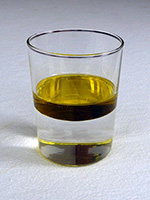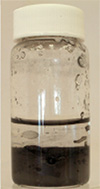How to make Graphene at home
It turns out that many people want to make their own graphene at home, and yes, it is possible to create small quantities
of graphene by yourself! However, although possible, it's not easy to make considerable amounts. In fact, as of this writing,
scientists still have no clue how to efficiently make graphene in large quantities and high qualities, because the technological processes have not yet been
developed.
The bits you will be able to make in home conditions will be only a few nanometers in length,
so forget about macroscopic graphene sheets or strips. The largest piece of graphene that you can make yourself is
about 0.25mm2 (but you'll make a lot of them). That's not much larger than the area of the dot in an exclamation mark on this webpage!
In industrial uses, scientists make transistors with gate lengths of under 25nm... so your dot-sized piece of
graphene, although it looks insignificantly small to you, could be used to make hundreds of transistors.
Still interested in making graphene? Great, read on!
Method 1: Sticky-tape
The first method is to use a lead pencil to deposit a thick layer of graphite
onto a paper. Then use ordinary sticky tape to peel off a layer of graphite from the paper. Use another piece of sticky
tape to remove a layer of graphite from the first sticky tape. Then, use a third piece of unused sticky tape to remove a layer from
the second piece of sticky tape, an so on. Eventually, the graphite layers will be thinner and thinner, and you will end up with graphene,
single-layer or few-layer graphite. Even though this is a proof-of-concept, the sticky tape method works. It takes patience and time,
but it's the method which the Manchester group used in 2004.
And remember, they actually won a nobel prize for their work, so there's no messing with sticky tape!
Method 2: The kitchen blender
A group of scientists had their article published on April 20th 2014, in which they describe how to make graphene using an approach
called liquid shear exfolation. You can find the article abstract
here but the full article is behind a paywall.
Shear exfoliation in liquids starts by pouring powdered crystal in a liquid, and then using a shear mixer to separate (exfoliate)
layers of material from the crystal. The liquid that is used in such processes is chosen so that the small graphene particles don't
clump back together, and the result is a liquid suspension of graphene. The suspension can then be dried to obtain graphene nanoflakes, or
it could be directly used in later technological processes, such as making of graphene coatings and others.
So, how do you make graphene at home using this method? Well, you can replace the shear mixer with a kitchen blender
(since shear mixing is a fancy word for high-tech blending), and instead of special liquids you can use water and dish detergent.
The detergent is added so that the particles don't clump, and acts as a surfactant. A great source of graphite powder are graphite pencils.
Simply powder a few pencil leads and add the powder to the detergent solution, then blend for a while. Unless you have access to
special microscopes and other equipment, you will probably be unable to confirm the existence of graphene in your detergent solution, but there's a
quick rule of thumb which you can use to estimate the particle size. Generally speaking, if the graphene particles are
too big, they will sink to the bottom of the vessel, while if they are smaller, they will float to the top. Nanoparticles are so small that
they will be suspended in mid-water, and this is what you're aiming for if you want to make graphene. After you make enough graphene
particles, you might want to filter the suspension and leave it to dry.
That being said, although this method was described in the paper mentioned above and it worked for the researchers,
don't get too excited about making graphene at home this way. It's messy and creates very small flakes of graphene, not something to
brag to your friends about, unless you have a high tech lab in your basement and intend to use them to make graphene transistors. On the other hand,
this technology, along with
sonication assisted liquid phase exfoliation might define how graphene is made in the future in industrial settings, because of its scalability.
Method 3: DVD burner - LightScribe technology approach
To use this method, you need a DVD computer drive with LightScribe technology,
as well as some graphite oxide. You may obtain graphite oxide from a manufacturer, or you can make some graphite oxide at home for
this experiment. If you want to find out how to make graphite oxide at home, scroll down to the next section
Graphite oxide is water-soluble, so after mixing it with water, carefully pour it on a DVD
disc. Make sure the graphite oxide solution is evenly distributed on the plastic surface of the disc. After the solution
has dried and created a film of graphite oxide on the disc, place the disc into the DVD drive, film-side down.
Use the LightScribe software to burn in the layer of oxide. The areas of the film which come into contact with the
laser beam will be turned into graphene. What actually happens is a reduction reaction which reduces graphite oxide back
into graphene. The resulting graphene layer should be carefully removed from the disc and cut into appropriate sized
pieces. These pieces can be used directly to create a graphene supercapacitor!
One reader suggested that the LightScribe DVD laser can be replaced using a simple Xenon flash. If you have a photo-flash,
you could try this approach as well, and report the results to us at "contact at our site domain". Another tip: do NOT do this
if you are not comfortable with voiding the warranty of the DVD burner.
Method 4: Heptane-water interface film formation

Oil floating on water.
This is the newest DIY graphene recipe we've heard so far. It involves a bit of fluid physics to explain what's going on here first.
If you pour a non-water-soluble liquid into water it will either float on top of the water, or the water will float on top of it,
depending on whether the added liquid is heavier (more dense) or lighter (less dense) than water. A common example is oil floating
on top of water (see image).
One group of scientists [1] discovered that you can make graphene by pouring two solvents which do
not mix together, such as heptane and water, into a glass and adding finely ground graphite powder and putting it in a sonication bath.
You can buy heptane in most chemical supply stores, water is readily available (it's a good idea to use distilled water),
and you can easily obtain graphite sticks in art shops. An ultrasound bath is needed, but these are not uncommon on ebay and the likes.
The resulting graphene is one to four layers thick, and is chemically stable. It can be extracted and deposited on a clean glass plate,
or any other substrate.

Graphene on the water-heptane interface.
The idea is to mix the finely ground graphite with water and heptane (1:1 ratio of water and heptane) and sonicate it for a while.
What happens next is that graphite flakes exfoliate at the interface between water and heptane and graphene actually starts "climbing"
up the glass walls of the vial. If a hydrophilic substrate, such as a glass slide, is introduced through the interface, a thin film
of graphene will climb the walls of the slide as well. The glass slide can then be extracted and after drying, you'll be left with
graphene-coated glass. If you use a polyethylene vial, the resulting graphene will not climb the walls of the vial, but you can
still extract it with a slide made of glass or other hydrophilic material. The result is shown in the image on the right.

Graphene on glass.
The final product of this graphene making process is shown on the image on the left.
Graphene is deposited as a thin film on both sides of the glass plate,
and its slight light-absorbing properties can be seen by looking through it
(Graphene
absorbs about 2.3% of visible light). The explanation of the process is that
graphene self-reassembles from the small exfoliated flakes on the interface between water and heptane because the surface
tension of graphene (54.8 mN/m) is nearly right between the surface tension of water (72.9 mN/m) and heptane (20.1mN/m).
The thickness of the graphene film is limited by capillary forces on the interface and the excess graphene will simply fall to
the bottom of the vial. The formation of thick aggregates is suppressed by the diffusion and the energy requirement needed to
form a new layer. For more information, please refer to the original paper
[1]
This is possibly the easiest way to make DIY graphene at home as an arbitrarily large sheet. Other methods only create graphene
flakes, but these flakes could possibly be used instead of graphite flakes in this method as a refinement stage.
Try it and let us know how it goes!
How to make Graphite oxide at home?
Disclaimer
In order to make graphene at home using the DVD method listed above, you'll need some graphite oxide. You may buy graphite oxide
from various sources, including online, or you may try making graphene oxide yourself. In this text, we will explain how you can make
graphene oxide at home, yourself. The procedure is relatively simple and most ingredients can be bought over the counter.
However, please note that this is NOT a safe procedure and following this guide could lead to explosions, fires and serious injury.
For obvious reasons, should you choose to do this yourself, observe precautions when working with acids and explosive materials.
As a matter of fact, we believe that unless you are a licenced chemist, you are better off buying graphene oxide rather than
trying to make it at home. We offer this text as an educational resource only. By proceeding to read
the following text, you acknowledge that you understand the risks of working with chemicals listed in the text and have a complete
understanding of all the chemical reactions and dangers that they pose to your health and safety. To avoid fume and fire hazards,
perform this experiment outdoors and in a controlled, well ventilated environment. Even though care was taken to
ensure that there are no mistakes in the text, we take no responsibility for any eventual mistakes remaining in the text.
If you have access to a lab and you're doing this for a project or an experiment, drop us a note and let us know how it went.
We would love to include your success story here.
Introduction
Graphite oxide has been known for almost 150 years now. It was first prepared in 1859. There have been improvements in the process
since then, and many researchers in the field commented on the potential dangers and risks associated with the original procedure as
described by B. Brodie, who first discovered the process. The method outlined here takes about 2h at temperatures below 45 degrees
celsius if you have access to a centrifuge. If you do not, it will take a day or so for the excess water to evaporate from the container.
The procedure
Stir 100g of powdered graphite with 50g of sodium nitrate into 2.3 liters of technical sulfuric acid. Make sure to mix the ingredients
in a much-larger-than-needed leak-proof container placed in an ice-bath at zero degrees celsius, as a safety measure. The container should be
at least 15 to 20 liters in volume.
CAUTION! Add 300g of potassium permanganate to the mixture while constantly mixing the ingredients. Do NOT add all 300g in one go.
Instead, add potassium permanganate gram by gram carefully to avoid heating the mixture above 20 degrees celsius! CAUTION!
Potassium permanganate is a powerful oxidizer which stains skin and other organic materials such as clothing on contact.
When mixed with sulfuric acid, it produces a highly explosive manganese oxide, so all safety precautions must be taken! Make sure the maximum
temperature is not exceeded.
After the permanganate has been added to the mixture, remove the ice-bath and bring the temperature up to 35 degrees celsius.
Precisely and carefully maintain this temperature for 30 minutes. During this stage, the mixture will thicken and the amount of released
gas will reduce. At around the 20 minute mark, expect the mixture to be brownish-gray and of pasty consistence.
CAUTION! After 30 minutes have passed, slowly and carefully add 4.8 liters of water into the mixture while stirring. The addition of
water will cause an exothermic reaction which will increase the temperature of the mixture to close to 100 degrees celsius, and
large amounts of gas will be released in a violent reaction! Maintain the temperature at 98 degrees celsius for another 15 minutes.
CAUTION! The mixture will now be brown in color.
After maintaining the temperature for 15 minutes, further dilute the mixture to a total of 14 liters of fluid with warm water. Add 3%
hydrogen peroxide in order to reduce the leftover permanganate. After the addition of hydrogen peroxide, the mixture should turn bright
yellow.
Filter the mixture while still warm. The filter will take a yellow-brown color. Wash the filter cake three times with a total of 14 liters
of warm water. Disperse the resulting graphite oxide in 32 liters of water. In order to obtain dry graphite oxide, you would need a powerful
centrifuge. Since this is probably not available, heat the water containing graphite oxide to 40 degrees celsius and wait until the water evaporates.
A wide container works best, since the larger area will facilitate evaporation.
Higher quality graphite oxide obtained in this fashion will have a bright yellow color, while poorer quality graphite oxide will take on a
green to black hue. You can use this graphite oxide in an aqueous solution to perform your experiments with Lightscribe drives at home.
Further reading
For your convenience, we provide the original paper
where this process was described. We used this paper as the basis for our guide on how to make graphite oxide at home.
If in doubt, follow directions from that paper instead of directions stated on our website.
There are also several Youtube videos that show the complete process, and those might be a valuable resource as well.
We would like to thank our visitor Hera, who contacted us pointing out a typo in the text.
This page was last modified: June 6th, 2014.
Author: Nebojsa Mrmak


